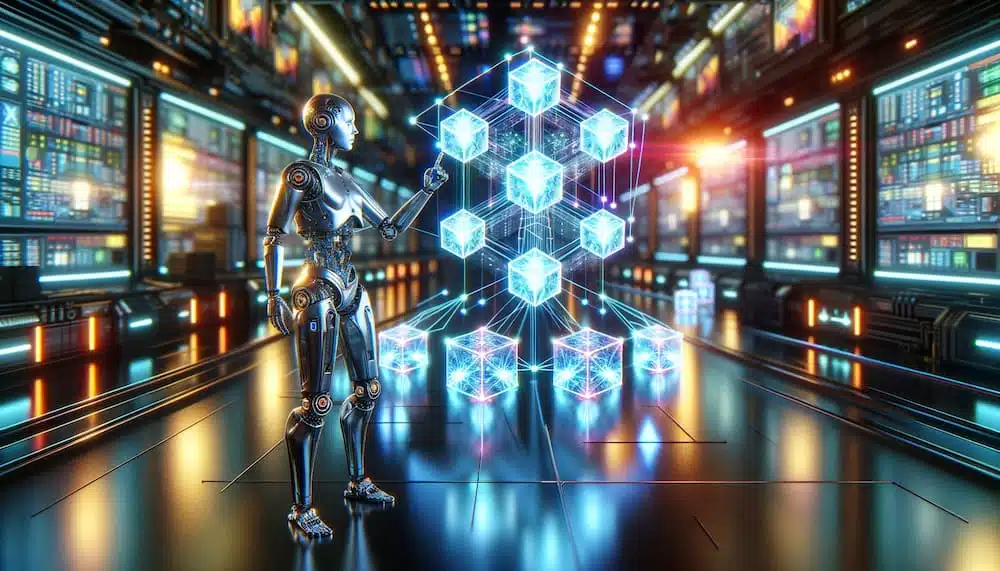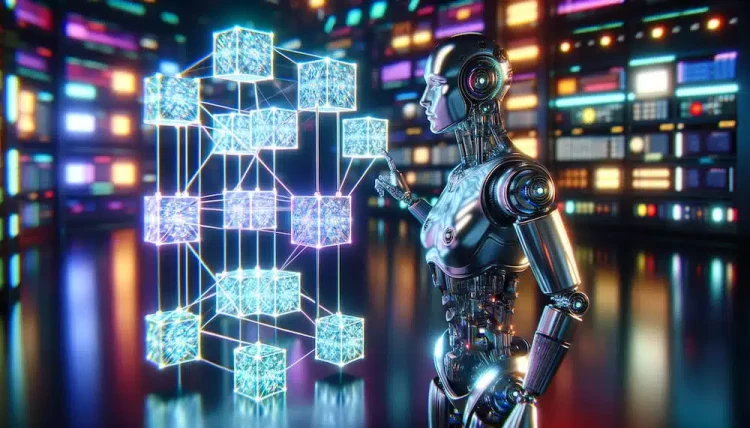Introduction
In recent years, the convergence of Artificial Intelligence (AI) and Blockchain technologies has sparked significant interest across industries. Both AI and Blockchain are already proving to be disruptive technologies in their own right, but their combination has the potential to drive entirely new industrial revolutions. As industries across the globe face unprecedented challenges in a rapidly changing world, the fusion of these two technologies offers the promise of a more intelligent, secure, and decentralized future.
This article will explore the potential impact of the integration of AI and Blockchain, focusing on the various ways in which this convergence could fuel new industry revolutions. We’ll look into sectors like finance, healthcare, supply chain management, manufacturing, energy, and more. Additionally, we will highlight the benefits and challenges that come with this fusion, as well as the promising future it holds for business transformation and technological advancement.
1. Understanding the Basics of Artificial Intelligence and Blockchain
Before diving into how AI and Blockchain will drive industrial revolutions, it’s crucial to understand what these technologies are and how they work.
1.1 What is Artificial Intelligence?
Artificial Intelligence (AI) refers to machines or systems designed to mimic human intelligence. AI can process information, learn from data, make decisions, and perform tasks autonomously. Some of the most common types of AI include:
- Machine Learning (ML): AI that learns from large datasets to identify patterns and make predictions or decisions.
- Natural Language Processing (NLP): Enables computers to understand, interpret, and generate human language.
- Computer Vision: Enables machines to interpret and understand visual data, such as images and videos.
- Robotic Process Automation (RPA): AI that automates repetitive tasks within business processes.
AI is revolutionizing many industries by improving decision-making, enhancing productivity, and enabling personalized customer experiences.
1.2 What is Blockchain?
Blockchain is a decentralized, distributed ledger technology that securely records transactions across multiple computers. It operates without a central authority, and every transaction is recorded in a block and linked to previous blocks, creating a chain of immutable records.
Key features of blockchain include:
- Decentralization: No single entity controls the data, making it more secure and transparent.
- Immutability: Once data is recorded on the blockchain, it cannot be altered or deleted.
- Smart Contracts: Self-executing contracts where the terms of the agreement are coded into the blockchain, automating and streamlining processes.
- Transparency and Trust: Blockchain enables verifiable transactions that are visible to all participants on the network, ensuring transparency and trust.
The combination of AI and Blockchain offers a powerful synergy that combines the intelligent decision-making capabilities of AI with the secure, transparent, and decentralized features of Blockchain.
2. Key Areas Where AI and Blockchain Convergence Will Drive New Industrial Revolutions
2.1 Revolutionizing Financial Services and DeFi
The finance industry has already been undergoing major transformations due to the rise of Blockchain and Cryptocurrencies. Decentralized Finance (DeFi) is reshaping traditional financial systems by eliminating intermediaries and providing decentralized financial services.
However, the integration of AI into this ecosystem will further enhance decision-making, improve risk management, and automate complex financial processes.
2.1.1 AI-Powered Blockchain in Risk Management
AI can analyze large datasets at high speed and detect patterns that may not be visible to humans. In the context of finance, AI-powered blockchain systems can help improve risk assessment, fraud detection, and regulatory compliance.
- Example: AI algorithms could assess real-time data from multiple sources (social media, market trends, historical data) and predict market shifts, enabling more accurate predictions of investment risks. Blockchain ensures that these predictions are recorded in a transparent and immutable ledger, providing security and accountability.
2.1.2 Autonomous Financial Transactions and Smart Contracts
Smart contracts, which are self-executing contracts with the terms of the agreement directly written into code, could be combined with AI to create more sophisticated and autonomous financial transactions.
- Example: AI could evaluate real-time market conditions and automatically trigger smart contract executions based on predefined criteria, such as asset price changes or economic events. This would enable faster, more secure, and efficient transactions without human intervention.
2.2 Transforming Healthcare Systems
The healthcare industry is one of the most promising areas for AI and blockchain convergence. AI is already transforming healthcare through predictive analytics, diagnostic tools, and personalized treatment plans. Blockchain, on the other hand, offers secure, transparent, and decentralized data storage solutions that are particularly useful in healthcare for storing patient records and medical data.
2.2.1 Decentralized Patient Data Management
AI can be used to analyze and process vast amounts of healthcare data to identify trends, predict outbreaks, and create personalized treatment plans. Blockchain can provide the secure storage and sharing of medical records, allowing patients to control access to their data while ensuring transparency and privacy.
- Example: AI could be used to monitor patient health in real-time and suggest personalized interventions, while blockchain can securely store and share the medical data with doctors and healthcare providers across different facilities, enabling interoperability between hospitals and clinics.
2.2.2 AI in Drug Discovery and Supply Chain Transparency
Blockchain’s transparency and AI’s predictive capabilities can be combined to enhance drug discovery and streamline the pharmaceutical supply chain.
- Example: Blockchain could provide an immutable record of the entire drug development process, while AI can analyze existing research and data to predict potential compounds or molecules for new drugs, speeding up the discovery process. Additionally, AI and Blockchain could work together to ensure the authenticity and traceability of pharmaceutical products, reducing the risk of counterfeit drugs entering the market.
2.3 Enhancing Supply Chain Management and Logistics
Supply chains are complex networks involving various stakeholders, suppliers, and distributors. Blockchain and AI, when combined, can optimize and secure supply chain processes, enhancing transparency, traceability, and efficiency.
2.3.1 Blockchain and AI for End-to-End Transparency
Blockchain’s ability to provide a transparent and immutable record of transactions, coupled with AI’s ability to process large datasets and make predictions, can enhance supply chain visibility.
- Example: AI can predict supply chain disruptions, while blockchain ensures that the entire supply chain process, from raw material sourcing to final product delivery, is tracked in a transparent and tamper-proof manner. This would help businesses identify inefficiencies and improve decision-making.
2.3.2 AI-Powered Smart Contracts in Logistics
Smart contracts could be used to automate the execution of transactions between various supply chain parties. AI could optimize the execution of these contracts based on factors such as demand fluctuations, supply shortages, and transportation routes.
- Example: AI can predict when and where supply shortages are likely to occur, and smart contracts on the blockchain can automatically trigger orders for replacement products, ensuring the supply chain runs smoothly without manual intervention.
2.4 Revolutionizing Manufacturing and Industry 4.0
The convergence of AI and blockchain has the potential to revolutionize manufacturing, especially with the ongoing development of Industry 4.0, which focuses on smart factories and automation.
2.4.1 AI-Driven Blockchain for Industrial Automation
AI can help optimize production processes, predict equipment failures, and improve operational efficiency in manufacturing. Blockchain, on the other hand, can provide secure, real-time data storage and supply chain management, allowing manufacturers to track the production lifecycle from raw materials to finished products.
- Example: In an automated factory, AI could monitor the performance of machinery and predict when maintenance is needed. Blockchain could then ensure the transparent and secure tracking of maintenance records, production statistics, and product quality assurance data.
2.4.2 Securing Intellectual Property with Blockchain
In industries where intellectual property (IP) is crucial, blockchain can provide a secure and transparent ledger of ownership rights, ensuring that innovation is protected. AI can assist by identifying new patterns in existing designs, facilitating the development of new products.
- Example: AI could analyze patents and designs to recommend improvements, while blockchain could register and verify these intellectual property rights, providing proof of ownership and reducing IP theft.

2.5 Impact on Energy and Sustainability
Energy consumption and sustainability are becoming increasingly important in today’s world. The integration of AI and blockchain can lead to smarter energy grids, more efficient energy consumption, and better tracking of environmental impact.
2.5.1 AI and Blockchain in Energy Distribution
AI can be used to predict energy demand and optimize the distribution of energy resources. Blockchain can provide secure, transparent transactions for energy trading and consumption, allowing individuals and businesses to buy and sell energy on decentralized platforms.
- Example: A smart grid powered by AI could optimize energy distribution in real-time, while blockchain could ensure the transparency of energy transactions, reducing fraud and providing a clear audit trail.
2.5.2 Renewable Energy and Carbon Credit Tracking
Blockchain can provide transparency in the renewable energy sector, enabling the tokenization of carbon credits. AI can predict carbon emissions and help companies offset their emissions by purchasing carbon credits through blockchain-based platforms.
- Example: AI algorithms can assess the environmental impact of a company’s operations, and blockchain can track carbon credits securely, allowing companies to purchase or trade credits and ensure that sustainability targets are met.
3. Challenges and Considerations
While the convergence of AI and Blockchain holds enormous potential, several challenges must be addressed for it to reach its full potential:
- Scalability: Blockchain networks can face scalability issues, especially with high transaction volumes. Integrating AI can further strain the system, requiring improvements in blockchain infrastructure.
- Data Privacy: Blockchain ensures transparency, but AI often relies on sensitive data. Balancing data privacy with the transparent nature of blockchain will be crucial in certain industries like healthcare and finance.
- Regulatory Frameworks: Both AI and blockchain are in the early stages of regulatory development. Clearer policies and standards will be required to ensure responsible usage, particularly in sectors like finance and healthcare.
Conclusion
The combination of Artificial Intelligence and Blockchain will drive industrial revolutions across a wide range of sectors, from finance and healthcare to manufacturing and energy. By enabling decentralization, enhanced security, automation, and efficiency, these technologies will radically change the way businesses operate and how consumers engage with services.
While challenges remain in terms of scalability, privacy, and regulation, the potential of AI and blockchain to transform industries is undeniable. As both technologies continue to evolve, their synergy will unlock new opportunities for innovation, collaboration, and growth, ultimately creating more intelligent, secure, and decentralized ecosystems for the future.
















































